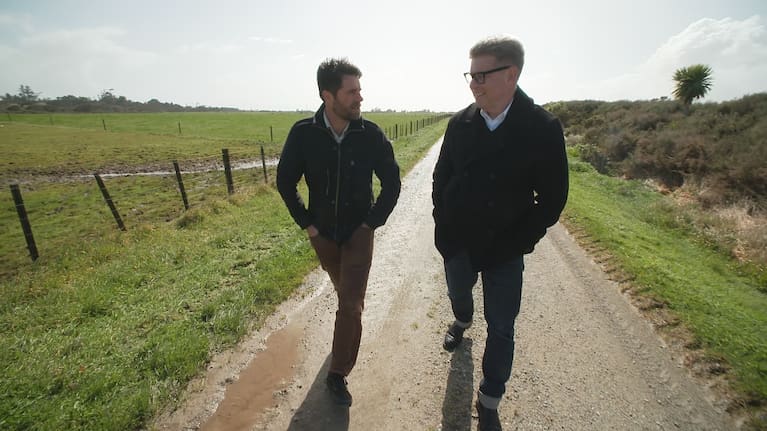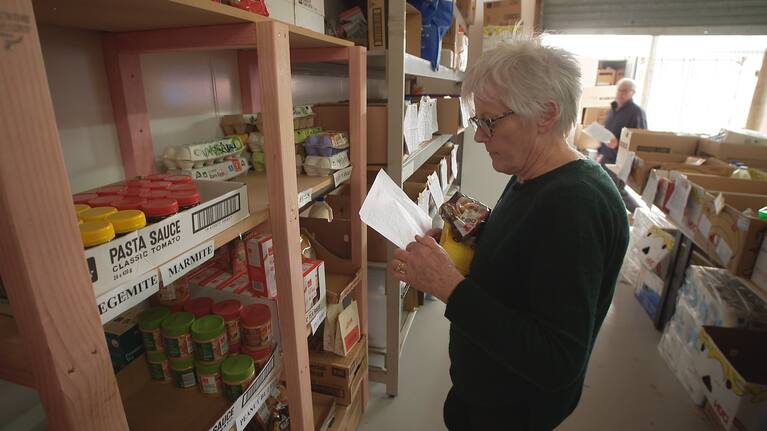John Campbell hit the road and visited three very different regions – Ruapehu, Wairarapa and the West Coast – to gauge the mood of the towns and hear about their plans. You can watch the story on TVNZ+ and read Campbell’s interview with Emily Simpson below.
ES: What was the motivation behind this road trip to three quite distinct New Zealand towns?
JC: I started thinking about it when I did a big story about New Zealand’s water infrastructure earlier this year. I was travelling to small towns, talking to local politicians about Local Water Done Well, which is the Government’s policy to replace Three Waters.
The new policy is sort of saying to councils “the water infrastructure is yours, off you go”. It’s appealing, that autonomy, “by-the-region-for-the-region” and all that. But the problem with these geographically large areas with really small populations is that there’s no economy of scale. Eketāhuna is so far from anywhere that it needs its own wastewater treatment plant but, with a population of 540 people, there aren’t enough ratepayers to maintain it along with all the other water treatment plants in Tararua. So, if we say, “you do it”, it’s reasonable to respond, “how – and with what?” Buller has about 8000 rate payers, it’s not even the size of an Auckland suburb, and it’s facing these existential climate change issues.
I kind of became obsessed with the disparity between the intent and the resources. And I was interested to go into three very different communities to see how they’re facing, or have faced, the precariousness of their own futures.

ES: That sounds a bit depressing…
JC: I loved it; I loved the trip. I thought it would be as gloomy as hell but actually afterwards I felt energised by the people I met, their pragmatism and their optimism. But the problem is, they can’t do it alone.

At some stage it’s not enough for those of us who live in cities to keep saying, “wow look at how beautiful New Zealand is out there!”. Everyone travelling between Wellington and Auckland takes a photo of Mount Taranaki from the plane – but that can’t be our relationship with the regions, that doesn’t pay any bills. We have to go there, we have to spend there, we have to collectively look after those communities, and look at how we resource them. And we have to understand that responding to climate change costs money. And delaying our response to climate change costs more money.
ES: You went to the West Coast, the Wairarapa and Ruapehu, why did you choose towns in those regions?

JC: Some people questioned why we chose to visit Martinborough because it’s kind of rarefied now – there are a lot of Range Rovers driving around Martinborough – but, 33 years ago, that wasn’t the case.
In 1991, when I was a very junior reporter for 3 News, I was sent over the hill from Wellington to do a story about “the death of Martinborough” because the sawmill and the post office had closed. Martinborough was on the ropes, you know? It was a beautiful sunny day, and someone said to me “wine will save this town”. And I thought, “you’re mad, nothing’s going to save this town”. I was so struck by the audacity of thinking that pinot noir could save a town and, lo and behold, it has. I’ve always held that story as an example of believing people who have a vision, when that version is predicated on something sound – and, in that case, it was soil science.
Of course not all communities are going to suddenly realise they’re sitting atop some of the best wine-growing land in the world.

ES: Didn’t you also visit a food bank in Martinborough?
Yeah I did – when communities succeed, the local cost of living goes up – there are wealthy people, empty weekend homes, Airbnbs. So, out of nothing, Martinborough built an extraordinary future for itself but then the cost of living skyrockets and the low income workers that hospo and hort communities rely on for their success can’t afford to live there.

ES: Are small-town foodbanks different to city ones?
JC: There are no really large employers in Martinborough, so the foodbank is full of stuff from the local Four Square and the butchers – there’s a huge number of volunteers, a guy came in with a great big box full of vegetables from his garden. It felt like a community that knew its luck hadn’t spread to everyone, and the poor are harder to look away from in small towns. One volunteer commented that some of the food parcels would be going to people who live in his street.
But no one is being glib about this – as the lovely woman who runs it, May Croft, says: The best food bank is no food bank.

ES: Ruapehu has been in the news lately, with the Winstone mill closures – how are they going?
JC: Yeah, mill closures, which are such bad news, climate change making winter shorter for their ski fields. They can’t catch a break. And, again, they’ve got a tiny ratepayer base, so when people urge them to develop their immense tourism potential, the question is, “with what?”
But I was fascinated to learn that they’re transitioning from a winter holiday destination to a summer one. You know, the maunga, the forests, the river. The Forgotten World Highway. And, which I’d love to do, the trip from Mount Ruapehu, through the native forest, down the Whanganui River, to the Tasman… magic! But the famous and crazy Chateau Tongariro Hotel is currently closed. So there aren’t enough beds for tourism growth. The wonderful Northern Explorer train passes through the region but that only has genuine economic value if people get off, stay for a couple of days, then continue on. So, the question is, how do they develop their immense tourism potential, with bugger all money, whilst preserving and protecting the thing the tourists want? It’s big!

ES: What sort of future do you see for a place like Westport?
JC: Westport used to have a reputation for being a bit sort recalcitrant and reluctant to address climate change but, it seemed to me when I was there, that had changed and that felt really exciting. There’s a matter-of-factness in Westport. In the same way that they said, if we have mines, let’s mine them, they are now saying, “the flooding is real, it keeps happening, let’s do something about it”.

They’ve had so much flooding. And they want their response to contain leadership. I feel like Westport could be world-leading in their climate change response; they could be a template for flood-prone communities. The mayor is a dairy farmer who understands the land and what climate change will do to it. His name’s Jamie Cleine. He, and everyone I spoke to said, “if not us then who? If not now than when?” We would demonstrably not been in this shit, if people had asked that 20, 30, 40, 50 years ago. I really hope Westport does it. If they can get the town to buy in to this vision, something remarkable will be happening.

ES: Why are small towns so important to New Zealand?
JC: Who are we as a people? Predominantly, because we live where the jobs are, we’re urban dwelling. But we farm and we grow and, when we can, city dwellers head out to explore and almost venerate our forests and beaches and awa. That’s why hundreds of thousands of people watch Country Calendar every week. Many are city dwellers, dreaming of that other Aotearoa – New Zealand. My children were born and raised in central Auckland. They’ve almost never been on a farm and they don’t closely know any farmers, so – for some of us – that sense of New Zealand seems illusory, but it’s not. And farming and growing and tourism pay the bills.

The tourists who come here want the pristine native forests and the unspoiled coasts, and we will rely more and more and more on people coming here from Berlin and Tokyo to see those things. And we have a duty of care. Not only for each other, but for this place. We have to get this right.








